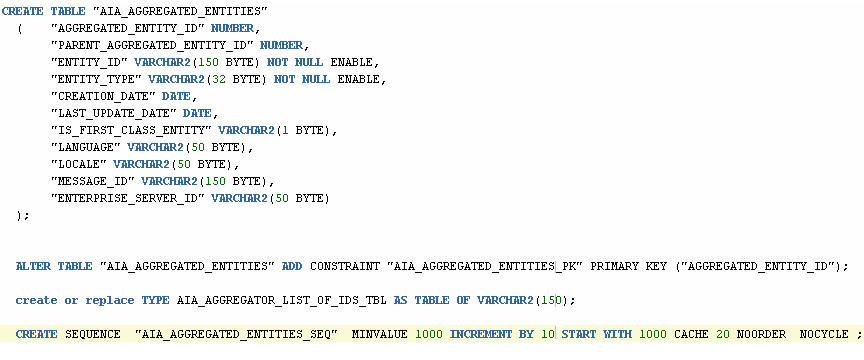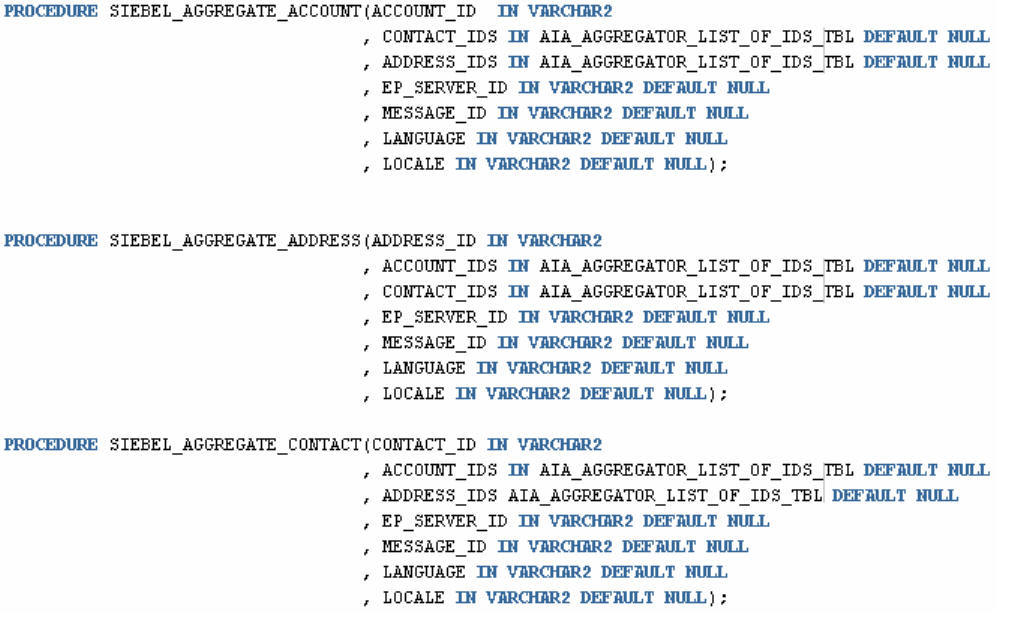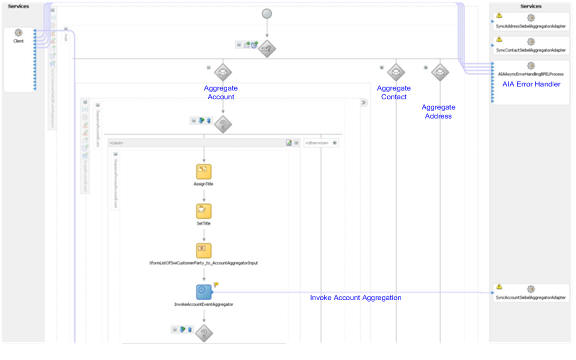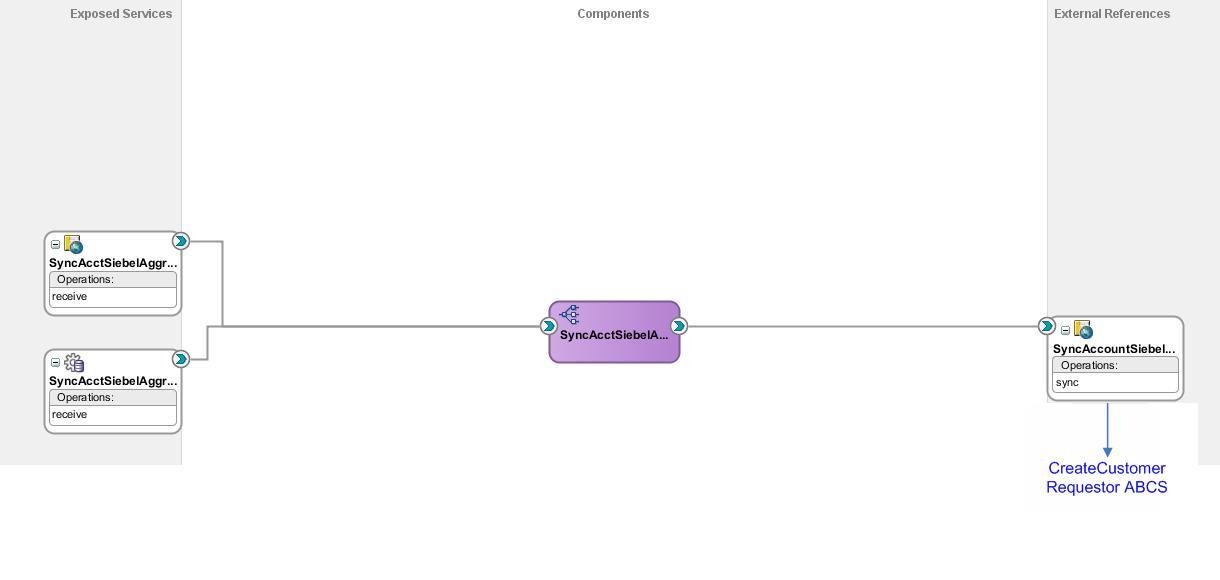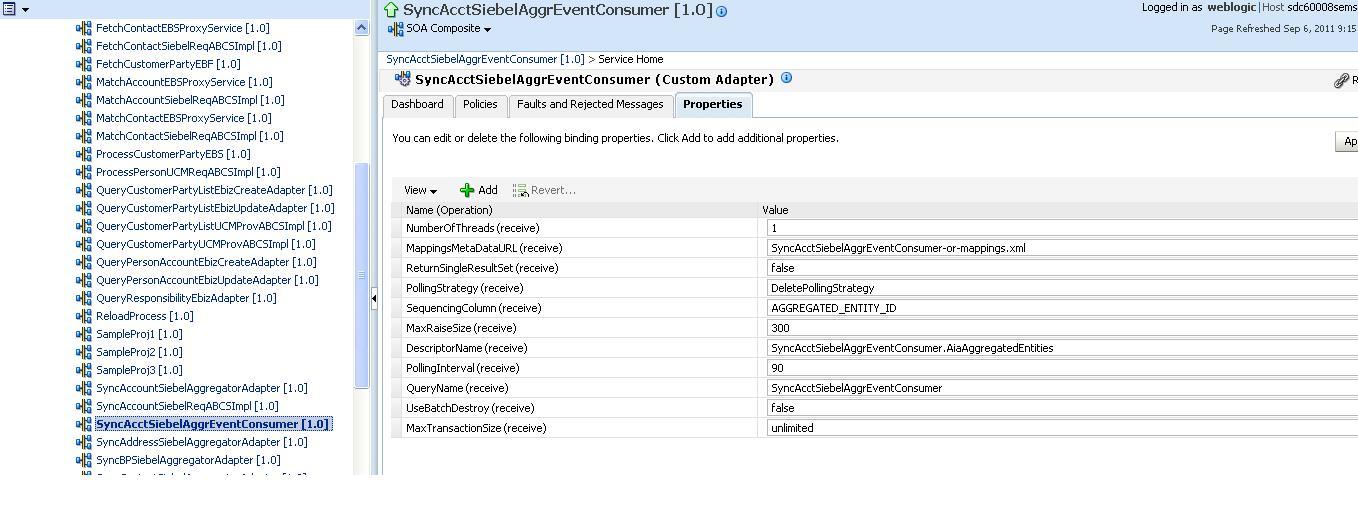22 Describing the Event Aggregation Programming Model
This chapter provides an overview of the Event Aggregation programming model and discusses how to implement it.
This chapter includes the following sections:
22.1 Overview
The Event Aggregation programming model provides a comprehensive methodology for business use cases in which event, entity, and message aggregation is necessary.
For example, Event Aggregation may be needed in a case in which multiple events are being raised before the completion of a business message, and each incomplete message triggers an event, which causes a business event in the integration layer.
The Event Aggregation programming model helps to create a coarse-grained message (event) from fine-grained messages (events) generated at discrete intervals. The messages, which are generated at certain intervals, may be incomplete or duplicates.
The Event Aggregation programming model can be used for relationship- and time-based aggregation.
The Event Aggregation programming model provides:
-
Synchronization of an entity, providing a single, holistic view of the entity.
-
Consolidation of several fine-grained events into a single coarse-grained event.
-
Merging of duplicates of the same event.
-
Increased performance.
Parallel simulations of fine-grained applications usually generate a large number of messages. The overhead for sending these messages over a network can dramatically limit the speed of a parallel simulation. In this case, event aggregation can increase the granularity of the application and reduce the communication overhead.
The Figure 22-1 illustrates how Event Aggregation can be achieved in a business integration scenario. Create Customer is a coarse-grained event and Create Contact, Create Account, and Create Address are the fine-grained events that are produced by the Event Producer. The Event Aggregator service can be used to consolidate all of them and raise a single coarse-grained event.
Figure 22-1 Event Aggregation Service Raising a Single Coarse-Grained Event from Multiple Fine-Grained Events

22.1.1 Event Producer
The Event Producer produces the messages that are aggregated. The messages produced could be incomplete and related to or dependent on other messages.
For example, the Event Producer could be a Siebel CRM system in which a new Account object is created, triggering an associated event. This Account entity may have a Contact entity as a child object, which may raise another fine-grained event when it is created along with the Account entity.
22.1.2 Event Aggregator Service
The Event Aggregator Service consolidates fine-grained events and then raises a single coarse-grained event. Implement the relationship between the Contact, Account, and Address events using Java or PL/SQL.
There are two parts to the Event Aggregator Service.
The first part implements the actual programming logic to maintain the aggregation and relationship between the entities.
The second part is the service wrapper that invokes this programming logic from the external client. If the programming logic is developed using PL/SQL, then these database objects can be exposed using a database adapter interface. If the programming logic is developed in Java, then the Java object can be exposed using the Web Services Invocation Framework (WSIF) interface.
Oracle recommends the use of BPEL to serve as the front end of the Event Aggregator Service. When the Java or PL/SQL object is invoked, it may fail for various reasons, in which case they must be handled by notifying the Event Producer. BPEL provides fault and exception handling functionality that makes it a good choice for this scenario.
Oracle recommendeds the use of Java to implement the programming logic that maintains the relationships between entities. This is because extensibility, modularity, and exception handling are comfortable with Java.
22.1.3 Consumer Service
The real event aggregation happens in the database. This is a time-based aggregation, which means that the Consumer Service spawns a thread to poll the table object with the help of the database adapter and looks for the messages pushed into the table. The polling occurs based on a configurable time interval. The Consumer Service fetches all messages that fall into that particular time interval and passes them to the requestor application business connector (ABC) service.
After the messages are fetched from the database, the Consumer Service deletes them.
22.2 Implementing the Event Aggregation Programming Model
Implementing the Event Aggregation programming model involves creating an Event Aggregation Service and a Consumer Service, and implementing error handling.
Using this approach, the aggregation occurs in the database layer with the help of a single self- referencing table and stored procedures. The self-referencing aggregation table structure supports multilevel relationships between entities.
The stored procedures help populate the aggregation table upon appropriate event generation. This also helps to eliminate duplicate records for first-level objects. The stored procedure obtains an optimistic lock before updating records in the aggregation table.
Use Case: Customer Master Data Management, with Siebel CRM
This implementation discussion is based on this use case.
In the Oracle Customer Master Data Management (MDM) Customer process integration flows, the Siebel CRM application has create and update triggers defined at the business layer level. Any update or create action can potentially lead to multiple events being raised for integration. Therefore, aggregate these events and process them in batches, instead of processing each fine-grained event individually.
These events may be raised on these business entities: Account, Contact, and Address.
These relationships between the Account, Contact, and Address entities must be maintained throughout the aggregation:
-
An Account can have one or more Contacts and Addresses attached to it.
-
A Contact can have one or more Addresses attached to it.
-
A Contact and Address can be shared across multiple Accounts.
22.2.1 Creating the Event Aggregation Service
This section discusses the creation of the Event Aggregation service, including how to:
-
Create the PL/SQL objects
-
Create the database service and aggregate service
22.2.1.1 Creating the PL/SQL objects
-
Create a table object "AIA_AGGREGATED_ENTITIES" in the database as illustrated in Figure 22-2.
-
Create a stored procedure object "AIA_AGGREGATOR_PUB," which contains the programming logic to maintain the relationships between the Contact, Account, and Address events in the table object created in step 1 as illustrated in Figure 22-3.
22.2.1.2 Create the Database Service and Aggregate Service
To create the database services and aggregate service:
-
Create a BPEL project to invoke the database services created in the previous procedure as illustrated in Figure 22-4.
In case of an unavailable database, failure of a stored procedure, or any other error at the service level, this service should implement error handling to gracefully notify the client service.
Note:
For more information, see Section 22.2.3, "Implementing Error Handling for the Event Aggregation Programming Model".
The external client invokes this BPEL service for Event Aggregation.
Oracle recommends that external clients (Siebel CRM, for example) post messages to a persistent queue from which the Event Aggregator Service can pick up messages for event aggregation. If implementation of this recommendation is not possible, the Event Aggregator Service can be invoked directly from the external client.
22.2.2 Creating Consumer Service
To create the Consumer Service:
-
Create a consumer service with mediator composite.
Oracle recommends that you implement the Consumer Service using mediator, unless you must perform data enrichment. Use database adapter functionality to purge records from the database upon successful processing. Figure 22-5 illustrates how to implement Consumer Service using Mediator Composite.
-
Configure the time interval for polling on the consumer service.
The real aggregation occurs based on this time interval set on the Consumer Service. The Consumer Service fetches messages that fall into a particular time interval and all records in the interval are processed as a batch. Figure 22-6 illustrates how to configure time interval for polling on the consumer service.
Note:
For information on how to configure polling interval and other configurable properties, see section "Configuring PollingInterval, MaxTransactionSize, and Activation Instances" in Oracle Fusion Middleware User's Guide for Technology Adapters.
22.2.3 Implementing Error Handling for the Event Aggregation Programming Model
Error handling for the Event Aggregation programming model should follow Oracle Application Integration Architecture (AIA) error handling recommendations.
Note:
For more information about the Error Handling framework, see "Setting Up Error Handling" in Oracle Fusion Middleware Infrastructure Components and Utilities User's Guide for Oracle Application Integration Architecture Foundation Pack.
When the Event Aggregator Service errors out, whether it is due to an unavailable resource or an application error, the error should be handled in the Event Aggregator Service layer and propagated to the Producer Service. If the event generated by the Event Producer is unable to participate in the aggregation, the Event Producer should be notified.
Oracle recommends using BPEL for the implementation of the Event Aggregator Service layer. BPEL helps that the user has greater control over error handling. Regardless of the programming language in which this layer is implemented, it must be able to handle application exceptions.
If the Event Aggregator Service is implemented in PL/SQL, it should provision to propagate the OUT parameter to the Event Producer. Defining proper OUT variables for exception handling can be as simple as providing a reply consisting of either a SUCCESS or FAILURE message to the Procedure Service.
If the Event Aggregator Service is implemented in Java, it should provision to propagate the exception using the WSIF interface. Define proper exception objects to be used in the WSIF interface.
